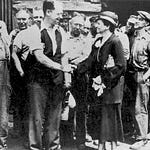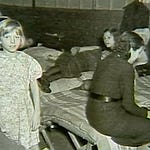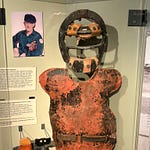Last summer, after touring the floodwall murals in Covington, Kentucky, I ate at a pizza joint called The Gruff, situated close to the Roebling Bridge. While the bar filled up with Cincinnati Reds fans, I had my first encounter with bacon-apple pizza at the recommendation of my winsome waitress. As we chatted, I learned she’d just finished high school and was figuring out her next move in life. In time, she asked about my research project, which led me to test a theory about how much Kentuckians remember about their history as a border state.
I asked, “Was Kentucky a Union or Confederate state?”
I could tell by the way her eyebrows shot up that the question surprised her. “Let me think while I run your credit card,” she said.
As I would have done at her age, she got it wrong. Kentucky never seceded from the Union. I just checked the Kentucky Academic Standards and it looks like my waitress would have studied the Civil War in eighth grade, which might explain her leaky memory, but it seems like the kind of thing that would have stuck in the way that you don’t need fingers to remember that 2+2=4. I’m not putting my waitress down or dismissing the quality of her education. In many ways, Kentucky presents itself to the world as a former Confederate state. As an aside, is eighth grade a bit early to study the complexities of the Civil War? Does it do any good to give eighth graders a survey course on something that still divides our country today? I’d love your thoughts.
This brings me to the subject of this month’s trivia: Kentucky and the Civil War. The quiz will lean heavily on research and analysis by the scholar Ann E. Marshall in her book, Creating a Confederate Kentucky: The Lost Cause and Civil War Memory in a Border State. That’s where I found this 1926 quote from E. Merton Coulter, who observed that Kentuckians “…waited until after the war was over to secede from the Union.”
Dr. Marshall reminds us that Kentucky’s white population identified as both Union and Confederate before and after the war, and that African-Americans, who identified with and fought for the Union, were eager to draw upon the Union victory to claim what had been promised to “all men” in the Constitution. That “emancipation narrative” never resonated with the majority of white Kentuckians, no matter their partisan affiliation. In the words of historian Patrick Lewis, Ph.D., “Kentuckians imagined themselves as the last remaining spokespeople with political power for a defeated South.”
With that, it’s time for the quiz.
Note to my fabulous new subscribers:
Monthly trivia is for sport. It’s not a test of intelligence or character. I couldn’t answer these questions without a significant amount of research, either! Do your best and enjoy learning something new. Answers in the footnotes.
QUESTIONS
The first four questions will help ground us in Kentucky’s economics and culture before the Civil War. Then we’ll move to the war years, and finally, the aftermath.
The African slave trade was outlawed by Congress in 1808, consequently raising the price of enslaved workers born into what’s known as the domestic slave trade. With proximity to the Ohio River, Lexington and Louisville became major slave markets. When the cotton gin created a cotton boom in the deep South, the average value of an enslaved worker sold in New Orleans rose from $500-1800 between 1800-1860. At the peak of the cotton boom (1850-60) how many enslaved people did Kentucky sell into the cotton belt?1
Over 37,000, making it the fourth highest state in the domestic slave trade.
At least 54,000, making it second only to Virginia.
The Commonwealth of Kentucky taxed enslaved workers as property, eventually assessing owners 22 cents per $100 of value. At the outbreak of the Civil War in 1861, with 250,000 enslaved workers in residence, what percentage of Kentucky’s tax revenue was based in human bondage/trafficking?2
10%
20%
35%
During Kentucky’s constitutional convention of 1849-1850, delegates debated the possibility of gradual, compensated emancipation. Proslavery forces in the state quashed all hopes of that. What did they accomplish instead?3
Section three in the 1850 constitution bill of rights strengthened owners rights, saying, “The right of property is before and higher than any constitutional sanction; and the right of the owner of a slave to such slave, and its increase, is the same, and as inviolable as the right of the owner of any property whatever.”
They chartered The Kentucky Colonization Society and allocated money to purchase land for freed slaves to settle in Liberia. The colony was called “Kentucky in Africa.”
They repealed Kentucky's Nonimportation Act of 1833 to remove a significant barrier to a profitable domestic slave trade. The goal was increased tax revenue for the state.
In the 1860 national election, Abraham Lincoln took 40 percent of the country’s vote. What percentage of Kentucky’s presidential vote went to its native son?4
28%
12%
1%
With Kentuckians’ divided in loyalty between Union and Confederacy, the legislature adopted a policy of neutrality at the beginning of the Civil War in 1861. Simultaneously, both sides began to build fortifications along the Ohio River border and rival factions organized militias—Confederate sympathizers called themselves the State Guards, while Unionists became the Home Guards. Sounds like a powder keg to me. What caused the legislature to break its neutrality policy?5
One month after Governor Magoffin proclaimed neutrality, Kentuckians chose Unionists for nine out 10 of the state’s congressional seats. Later, on August 5, Unionists also won control of the state legislature and affirmed allegiance to the Union.
On September 4, Confederate General Polk ordered the occupation of Columbus, Kentucky, a strategic location in the state’s southwest near Tennessee. The Kentucky legislature appealed for Federal troops to repel the invaders, and General Ulysses Grant answered the call.
On November 18, when a self-constituted group of Confederate sympathizers and delegates from Kentucky counties passed an Ordinance of Secession and established Confederate Kentucky; the following December it was admitted to the Confederacy as its 13th state.
Although most white men did not fight for either army, Confederate sympathizers in the eastern part of the state fought “citizen warfare” in the form of guerrilla attacks on Union supply and communication lines, and Union sympathizers themselves. African-Americans who attempted to enlist in the Federal army were tortured and killed. By 1862, Kentucky became a police state in the hands of Union generals, who wouldn’t allow suspected Confederate partisans to do which of the following activities? More than one applies.6
Hold elected office
Teach school
Minister to a church
Serve as a juror
Run a newspaper
By July 4, 1865, the war was over. How did most white Kentuckians celebrate this federal holiday?7
They displayed fireworks, cheered marching bands, and even suffered from heat stroke while listening to orators regale the crowds with patriotic speeches. Black Kentuckians were not permitted to celebrate with them.
They let the day pass un-marked.
Between 1865-1885, “Kentucky emerged as one of the most lawless states in America…(with) vigilantism, mob violence, and lynching on an unprecedented scale.” (Creating a Confederate Kentucky p 56.) Most experts agree that this lawlessness arose because Kentucky sat outside the “framework of federal Reconstruction.” Why wasn’t Kentucky subject to Reconstruction? After all, it was a slave state. All the hints are in the intro and answers to preceding questions.8
In Fairview, Kentucky, roughly 17 miles from the Tennessee state line, lies an historic site maintained by the state park system. The site's focal point is a 351-foot concrete obelisk that commemorates the birthplace of a Confederate leader who was born there in 1808. Construction began in 1917, stopped in 1918 during World War I, and resumed in January 1922. When finished in 1924 at a cost of $200,000, the Ku Klux Klan burned a cross from the top of the monument. Kentucky is obviously committed to this site; the state closed the obelisk to the public from 1999 until May 2004 for renovations and construction of a new visitor center. Whose birthplace is commemorated here? Your options are in alphabetical order.9
John C. Breckinridge
Jefferson Davis
John Hunt Morgan
Gustavus Woodson Smith
What is the legal status of slavery in Kentucky law today?10
The first Kentucky constitution of 1792 protected the right to own slaves. The Kentucky constitution still protects this right “as a punishment for crime, whereof the party shall have been duly convicted.”
In 2022, Kentucky joined the states of Alabama, Tennessee, Vermont, and Oregon in passing laws that say "slavery and indentured servitude in any form are prohibited."
Intermission
Chances are, some of the answers to these questions surprised you. Here’s a podcast series I’ve listened to twice now, and plan to listen again. “The Reckoning” is a public radio and podcast series which traces the history and lasting impact of slavery in America by looking at how the institution unfolded in Kentucky. Here’s an interview with the producer and lead interviewer, Dan Gediman.
ANSWERS
According to the University of Richmond’s American Panorama Project, during the height of the cotton boom between 1850-1860, Kentucky exported over 37,000 enslaved people, making it the fourth highest state in terms of exportation into the Deep South. The two largest exporting states were Virginia and Maryland. The correct answer is a.
The correct answer is 20%, b.
The only correct answer is a. Please note: this verbiage, “and its increase,” refers to the children of enslaved mothers. The heritability of slavery was economically important to enslavers and slave states.
The Kentucky Colonization Society of answer b. did exist. It was formed in 1816 and raised money to purchase about 40 acres of “Kentucky in Africa.” The primary settlement in the colony was Clay-Ashland, named after Henry Clay's Ashland Plantation.
The Nonimportation Act of 1833 prevented the importation of enslaved workers for the purpose of selling them. Migrants to the commonwealth could bring slaves with them for their own use, but had to agree not to sell them. Suffice to say, this wasn’t enforced. Anyhow, this act was repealed in 1849, and was not a part of the constitutional convention.
Here’s a KET video that explains the domestic slave trade and the Underground Railroad.
The answer is c., but more accurately, Lincoln got less than 1%. Source.
For further context, John Bell, the leading candidate from the Constitutional Union Party, won 45 percent of Kentucky’s popular vote, the most of the three candidates’ votes. Bell was viewed as the least radical of all the candidates; his platform contained one plank—the preservation of the Union. Therefore, 45 percent of voting Kentucky white men were one-issue voters. Source.
I want to briefly address how in the world a state could declare neutrality in a civil war. The answer is that it suited everyone to keep Kentucky neutral, at least for a while. For the Confederates, Kentucky was a barrier protecting Tennessee, at least as long as the Union respected Kentucky's neutrality. For the Union, it was important not to violate Kentucky's neutrality in order to avoid having Kentucky join the Confederacy.
All three answers are listed in the order they occurred, and the actual event that broke the neutrality was b., the taking of Columbus by Confederate forces.
The Commonwealth of Kentucky remained a Union state. Here’s the seal of the provisional Confederate government of Kentucky. I have no idea what this provisional government actually “did” because they certainly didn’t run schools or deliver the mail while they were traveling under the protection of the Army of Tennessee.
All of the answers are true. In time, one Union general created a prison in Newport for disloyal females and made them sew for the Union army. Things got progressively more stringent and arbitrary across the state at the hand of these Union generals while the Federal government generally turned a blind eye. Many white Kentuckians asked what benefit they had derived from loyalty to the Union. Source: Creating a Confederate Kentucky p 21-22
Undoubtedly some white Kentuckians marked the occasion, but not to the degree that Black Kentuckians did. For example, at Camp Nelson, a Federal army base, “the Negroes had a grand jubilee” as it was “the first Independence Day that had ever applied to them.” Thousands attended a similar celebration at Camp Dick Robinson. Of note is how the Confederate sympathizers of Clark County spent July 5, 1865, instead of the overlooked 4th. They honored a battle from two years earlier when John Hunt Morgan and his men raided Unionist-owned businesses and destroyed $100,000 of property in Lebanon, Kentucky. Source: Creating a Confederate Kentucky p 81.
The correct answer to this question is obviously b. African-Americans began creating new holidays out of Emancipation Day and the anniversaries of constitutional amendments. According to Creating a Confederate Kentucky, there was an inverse relationship between Black and white Kentuckians’ enthusiasm for what had been achieved by the war and how it would be remembered. “With African Americans so successfully appropriating the Union war victory to further their political goals, it is not surprising that mainstream conservative whites who sided with the Union during the war found it difficult to honor that past. As long as Union victory was so strongly equated with (B)lack emancipation and Republican politics, there remained little cultural and political ground upon which conservative white Unionists could celebrate.” Source: Creating a Confederate Kentucky p 93
Nothing prescribed for former Confederate states applied to Kentucky, including the Emancipation Proclamation and Reconstruction. This is also true of the other border states, Delaware, Marylandand Missouri.
How did this affect the enslaved? It wasn’t until the 13th Amendment was ratified that people enslaved in Kentucky were emancipated. Until that time, the main path to freedom for enslaved Kentuckians was flight to the North or, after 1864, military service. Thousands of former slaves who served in the United States Colored Troops were raised on Kentucky soil. By early 1865, the wives and children of Black soldiers also became free. According to historians James C. Klotter and Craig Thompson Friend, nearly 71% of enslaved Kentuckians gained their freedom through military service. Yet over 65,000 remained in bondage until the passage of the 13th Amendment. While the 13th Amendment was binding on all states once 27 of the then-36 states ratified it, Kentucky finally ratified it during the bicentennial year of 1976. A symbolic gesture.
The only correct answer is b., Jefferson Davis, who became president of the Confederate States of America. Two-thirds the size of the Washington Monument, Davis’ obelisk was meant to be the crown jewel of “The Jefferson Davis Memorial Highway” that would ferry auto tourists from one Confederate monument to another.
In the wake of 2020’s Black Lives Matter protests, the Kentucky Historic Properties Advisory Commission voted 11-to-1 to immediately remove a 12-foot marble statue of Davis from the Kentucky Capitol rotunda in Frankfort and send it across the state to the museum at the Davis birth site. It has not yet been displayed. The legislature has not let the matter rest.
The Fairview area was once pro-Union. But according to the Director of Collections and Research at The Filson Society, Patrick Lewis, Ph.D., it was after the war that Kentuckians rushed to embrace the Confederacy out of fear of what the postwar racial order would bring. “Kentuckians imagined themselves as the last remaining spokespeople with political power for a defeated South,” Lewis said. Source. I took this picture of an article written about Davis’ birthplace on a recent trip to the Filson:
The only correct answers is a. Earlier this year, Kentucky Senate Bill 231 was introduced to “prohibit slavery and involuntary servitude in all circumstances,” but it hasn’t yet been put on a statewide ballot. Source.
Part of answer b is true. Alabama, Tennessee, Vermont, and Oregon did pass legislation outlawing slavery in 2022. Louisiana rejected a proposal to change a line in the constitution that critics have argued still permits slavery and involuntary servitude. Source.














